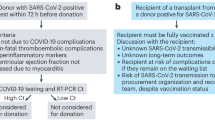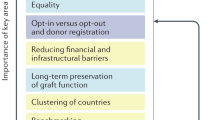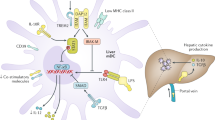Abstract
Since the introduction of organ transplantation into medical practice, progress and optimism have been abundant. Improvements in immunosuppressive drugs and ancillary care have led to outstanding short-term (1–3-year) patient and graft survival rates. This success is mitigated by several problems, including poor long-term (>5-year) graft survival rates, the need for continual immunosuppressive medication and the discrepancy between the demand for organs and the supply. Developing methods to induce transplant tolerance, as a means to improve graft outcomes and eliminate the requirement for immunosuppression, and expanding the pool of organs for transplantation are the major challenges of the field.
This is a preview of subscription content, access via your institution
Access options
Subscribe to this journal
Receive 12 print issues and online access
$209.00 per year
only $17.42 per issue
Buy this article
- Purchase on Springer Link
- Instant access to full article PDF
Prices may be subject to local taxes which are calculated during checkout


Similar content being viewed by others
References
Medawar, P.B. The behavior and fate of skin autografts and skin homografts in rabbits. J. Anat. 78, 176 (1944).
Owen, R.D. Immunogenetic consequences of vascular anastomoses between bovine twins. Science 102, 400–401 (1945).
Billingham, R.E., Brent, L. & Medawar, P.B. Actively acquired tolerance of foreign cells. Nature 172, 603–606 (1953).
Murray, J.E., Merrill, J.P. & Harrison, J.H. Renal homotransplantation in identical twins. Surg. Forum 6, 432 (1955).
Port, F., Wolfe, R., Mauger, E., Berling, D. & Jiang, K. Comparison of Survival Probablities for Dialysis Pateints vs Cadeveric Renal Transplant Recipients. J. Am. Med. Assoc. 270, 1339–1343 (1993).
Meier-Kriesche, H.U., Schold, J.D. & Kaplan, B. Long-term renal allograft survival: have we made significant progress or is it time to rethink our analytic and therapeutic strategies? Am. J. Transplant. 4, 1289–1295 (2004).
Suchin, E.J. et al. Quantifying the frequency of alloreactive T cells in vivo: new answers to an old question. J. Immunol. 166, 973–981 (2001).
Opelz, G. Correlation of HLA matching with kidney graft survival in patients with or without cyclosporine treatment. Transplantation 40, 240–243 (1985).
Cecka, J.M. The UNOS Renal Transplant Registry. in Clinical Transplants 2002 (ed. Cecka, J.M.a.T., P. I.) 1–20 (UCLA Immunogenetics Center, Los Angeles, 2002).
Goulmy, E., Gratama, J.W., Blokland, E., Zwaan, F.E. & van Rood, J.J. A minor transplantation antigen detected by MHC-restricted cytotoxic T lymphocytes during graft-versus-host disease. Nature 302, 156–161 (1983).
Linsley, P.S., Clark, E.A. & Ledbetter, J.A. T-cell antigen CD28 mediates adhesion with B cells by interacting with activation antigen B7/BB-1. Proc. Natl Acad. Sci. USA 87, 5031–5035 (1990).
Freeman, G.J. et al. Uncovering of functional alternative CTLA-4 counter-receptor in B7-deficient mice. Science 262, 907–909 (1993).
Durie, F.H. et al. Prevention of collagen-induced arthritis with an antibody to gp39, the ligand for CD40. Science 261, 1328–1330 (1993).
Libby, P. & Pober, J.S. Chronic rejection. Immunity 14, 387–397 (2001).
Russell, P.S. et al. Tolerance, mixed chimerism, and chronic transplant arteriopathy. J. Immunol. 167, 5731–5740 (2001).
Kirk, A.D. et al. Treatment with humanized monoclonal antibody against CD154 prevents acute renal allograft rejection in nonhuman primates. Nat. Med. 5, 686–693 (1999).
Thomas, J.M. et al. Durable donor-specific T and B cell tolerance in rhesus macaques induced with peritransplantation anti-CD3 immunotoxin and deoxyspergualin: absence of chronic allograft nephropathy. Transplantation 69, 2497–2503 (2000).
Kawai, T. et al. Long-term outcome and alloantibody production in a non-myeloablative regimen for induction of renal allograft tolerance. Transplantation 68, 1767–1775 (1999).
Ildstad, S.T. & Sachs, D.H. Reconstitution with syngeneic plus allogeneic or xenogeneic bone marrow leads to specific acceptance of allografts or xenografts. Nature 307, 168–170 (1984).
Sharabi, Y. & Sachs, D.H. Mixed chimerism and permanent specific transplantation tolerance induced by a nonlethal preparativew regimen. J. Exp. Med. 169, 493–502 (1989).
Kawai, T. et al. Mixed allogeneic chimerism and renal allograft tolerance in cynomolgus monkeys. Transplantation 59, 256–262 (1995).
Spitzer, T.R. et al. Combined histocompatibility leukocyte antigen-matched donor bone marrow and renal transplantation for multiple myeloma with end stage renal disease: the induction of allograft tolerance through mixed lymphohematopoietic chimerism. Transplantation 68, 480–484 (1999).
Buhler, L.H. et al. Induction of kidney allograft tolerance after transient lymphohematopoietic chimerism in patients with multiple myeloma and end-stage renal disease. Transplantation 74, 1405–1409 (2002).
Wekerle, T. et al. Allogeneic bone marrow transplantation with co-stimulatory blockade induces macrochimerism and tolerance without cytoreductive host treatment. Nat. Med. 6, 464–469 (2000).
Durham, M.M. et al. Cutting edge: administration of anti-CD40 ligand and donor bone marrow leads to hemopoietic chimerism and donor-specific tolerance without cytoreductive conditioning. J. Immunol. 165, 1–4 (2000).
June, C.H., Bluestone, J.A., Nadler, L.M. & Thompson, C.B. The B7 and CD28 receptor families. Immunol. Today 15, 321–331 (1994).
Linsley, P.S. et al. CTLA-4 is a second receptor for the B cell activation antigen B7. J. Exp. Med. 174, 561–569 (1991).
Lin, H. et al. Long-term acceptance of major histocompatibility complex mismatched cardiac allografts induced by CTLA4Ig plus donor-specific transfusion. J. Exp. Med. 178, 1801–1806 (1993).
Larsen, C.P. et al. CD40-gp39 interactions play a critical role during allograft rejection: suppression of allograft rejection by blockade of the CD40-gp39 pathway. Transplantation 61, 4–9 (1996).
Hancock, W.W. et al. Costimulatory function and expression of CD40-ligand, CD80, and CD86 in vascularized murine cardiac allograft rejection. Proc. Natl Acad. Sci. USA 93, 13967–13972 (1996).
Kirk, A. et al. CTLA4-Ig and anti-CD40 ligand prevent renal allograft rejection in primates. Proc. Natl Acad. Sci. USA 94, 8789–8794 (1997).
Levisetti, M. et al. Immunosuppressive effects of hCTLA4Ig in a non-human primate model of allogeneic pancreatic islet transplantation. J. Immunol. 159, 5187–5191 (1997).
Montgomery, S.P. et al. Combination induction therapy with monoclonal antibodies specific for CD80, CD86, and CD154 in nonhuman primate renal transplantation. Transplantation 74, 1365–1369 (2002).
Kirk, A.D. et al. Results from a human renal allograft tolerance trial evaluating the humanized CD52-specific monoclonal antibody alemtuzumab (CAMPATH-1H). Transplantation 76, 120–129 (2003).
Elzey, B.D. et al. Platelet-mediated modulation of adaptive immunity. A communication link between innate and adaptive immune compartments. Immunity 19, 9–19 (2003).
Abrams, J.R. et al. CTLA4Ig-mediated blockade of T-cell costimulation in patients with psoriasis vulgaris. J. Clin. Invest. 103, 1243–1252 (1999).
Kremer, J.M. et al. Treatment of rheumatoid arthritis by selective inhibition of T-cell activation with fusion protein CTLA4Ig. N. Engl. J. Med. 349, 1907–1915 (2003).
Larsen, C.P. et al. Rational development of LEA29Y (belatacept), a high affinity variant of CTLA4Ig with potent immunosuppressive properties. Am. J. Transplant. 5, 443–453 (2005).
Rothstein, D.M. & Sayegh, M.H. T-cell costimulatory pathways in allograft rejection and tolerance. Immunol. Rev. 196, 85–108 (2003).
Pearson, T.C., Madsen, J.C., Larsen, C.P., Morris, P.J. & Wood, K.J. Induction of transplantation tolerance in adults using donor antigen and anti-CD4 monoclonal antibody. Transplantation 54, 475–483 (1992).
Qin, S. et al. “Infectious” transplantation tolerance. Science 259, 974–977 (1993).
Walunas, T.L. et al. CTLA-4 can function as a negative regulator of T cell activation. Immunity 1, 405–413 (1994).
Freeman, G.J. et al. Engagement of the PD-1 immunoinhibitory receptor by a novel B7 family member leads to negative regulation of lymphocyte activation. J. Exp. Med. 192, 1027–1034 (2000).
Ozkaynak, E. et al. Programmed death-1 targeting can promote allograft survival. J. Immunol. 169, 6546–6553 (2002).
Li, Y. et al. Blocking both signal 1 and signal 2 of T-cell activation prevents apoptosis of alloreactive T cells and induction of peripheral allograft tolerance. Nat. Med. 5, 1298–1302 (1999).
Dai, Z., Konieczny, B.T., Baddoura, F.K. & Lakkis, F.G. Impaired alloantigen-mediated T cell apoptosis and failure to induce long-term allograft survival in IL-2-deficient mice. J. Immunol. 161, 1659–1663 (1998).
Larsen, C.P. et al. Long-term acceptance of skin and cardiac allografts after blocking CD40 and CD28 pathways. Nature 381, 434–438 (1996).
Wells, A.D. et al. Requirement for T-cell apoptosis in the induction of peripheral transplantation tolerance. Nat. Med. 5, 1303–1307 (1999).
Kurtz, J. et al. Mechanisms of early peripheral CD4 T-cell tolerance induction by anti-CD154 monoclonal antibody and allogeneic bone marrow transplantation: evidence for anergy and deletion but not regulatory cells. Blood 103, 4336–4343 (2004).
Benjamin, R.J. & Waldmann, H. Induction of tolerance by monoclonal antibody therapy. Nature 320, 449–451 (1986).
Waldmann, H. & Cobbold, S. Regulating the immune response to transplants. a role for CD4+ regulatory cells? Immunity 14, 399–406 (2001).
Moses, R.D., Sundeen, J.T., Orr, K.S., Roberts, R.R. & Gress, R.E. Cardiac allograft survival across major histocompatibility complex barriers in the rhesus monkey following T lymphocyte-depleted autologous marrow transplantation. III. Late allograft rejection. Transplantation 48, 769–773 (1989).
Holcombe, H., Mellman, I., Janeway, C.A., Jr, Bottomly, K. & Dittel, B.N. The immunosuppressive agent 15-deoxyspergualin functions by inhibiting cell cycle progression and cytokine production following naive T cell activation. J. Immunol. 169, 4982–4989 (2002).
Armstrong, N. et al. Analysis of primate renal allografts after T-cell depletion with anti-CD3–CRM9. Transplantation 66, 5–13 (1998).
Starzl, T.E. et al. Tolerogenic immunosuppression for organ transplantation. Lancet 361, 1502–1510 (2003).
Knechtle, S.J. et al. Campath-1H in renal transplantation: The University of Wisconsin experience. Surgery 136, 754–760 (2004).
Kirk, A.D. et al. Results from a human tolerance trial using CAMPATH-1H with and without infliximab. Am. J. Transplant. 2 Suppl 3, 379 (2002).
Pearl, J.P. et al. Immunocompetent T-cells with a memory-like phenotype are the dominant cell type following antibody-mediated T-cell depletion. Am. J. Transplant. 5, 465–474 (2005).
Sykes, M. Mixed chimerism and transplant tolerance. Immunity 14, 417–424 (2001).
Tang, Q. et al. In vitro-expanded antigen-specific regulatory T cells suppress autoimmune diabetes. J. Exp. Med. 199, 1455–1465 (2004).
Munn, D.H. et al. Potential regulatory function of human dendritic cells expressing indoleamine 2,3-dioxygenase. Science 297, 1867–1870 (2002).
Munn, D.H., Sharma, M.D. & Mellor, A.L. Ligation of B7–1/B7–2 by human CD4(+) T cells triggers indoleamine 2,3-dioxygenase activity in dendritic cells. J. Immunol. 172, 4100–4110 (2004).
Mirenda, V. et al. Modified dendritic cells coexpressing self and allogeneic major histocompatability complex molecules: an efficient way to induce indirect pathway regulation. J. Am. Soc. Nephrol. 15, 987–997 (2004).
Zheng, X.X. et al. Favorably tipping the balance between cytopathic and regulatory T cells to create transplantation tolerance. Immunity 19, 503–514 (2003).
Heeger, P.S. et al. Pretransplant frequency of donor-specific, IFN-gamma-producing lymphocytes is a manifestation of immunologic memory and correlates with the risk of posttransplant rejection episodes. J. Immunol. 163, 2267–2275 (1999).
Padovan, E. et al. Expression of two T cell receptor alpha chains: dual receptor T cells. Science 262, 422–424 (1993).
Lombardi, G. et al. Are primary alloresponses truly primary? Int. Immunol. 2, 9–13 (1990).
Murali-Krishna, K. & Ahmed, R. Cutting edge: naive T cells masquerading as memory cells. J. Immunol. 165, 1733–1737 (2000).
Gudmundsdottir, H. & Turka, L.A. A closer look at homeostatic proliferation of CD4(+) T cells: costimulatory requirements and role in memory formation. J. Immunol. 167, 3699–3707 (2001).
Ge, Q., Hu, H., Eisen, H.N. & Chen, J. Different contributions of thymopoiesis and homeostasis-driven proliferation to the reconstitution of naive and memory T cell compartments. Proc. Natl Acad. Sci. USA 99, 2989–2994 (2002).
Fan, X. et al. Donor-specific B-cell tolerance after ABO-incompatible infant heart transplantation. Nat. Med. 10, 1227–1233 (2004).
Gloor, J.M. et al. Overcoming a positive crossmatch in living-donor kidney transplantation. Am. J. Transplant. 3, 1017–1023 (2003).
Yang, Y.G. et al. Tolerization of anti-Galalpha1–3Gal natural antibody-forming B cells by induction of mixed chimerism. J. Exp. Med. 187, 1335–1342 (1998).
Ohdan, H., Swenson, K.G., Kitamura, H., Yang, Y.G. & Sykes, M. Tolerization of Gal alpha 1,3Gal-reactive B cells in pre-sensitized alpha 1,3-galactosyltransferase-deficient mice by nonmyeloablative induction of mixed chimerism. Xenotransplantation 8, 227–238 (2001).
Tryphonopoulos, P. et al. The role of donor bone marrow infusions in withdrawal of immunosuppression in adult liver allotransplantation. Am. J. Transplant. 5, 608–613 (2005).
Oike, F. et al. Complete withdrawal of immunosuppression in living donor liver transplantation. Transplant. Proc. 34, 1521 (2002).
Harper, A.M., Taranto, S.E. & Edwards, E.B. The OPTN waiting list, 1988–2001. Clin. Transpl., 79–92 (2002).
Cascalho, M. & Platt, J.L. The immunological barrier to xenotransplantation. Immunity 14, 437–446 (2001).
McCurry, K.R. et al. Human complement regulatory proteins protect swine-to-primate cardiac xenografts from humoral injury. Nat. Med. 1, 423–427 (1995).
Kolber-Simonds, D. et al. Production of alpha-1,3-galactosyltransferase null pigs by means of nuclear transfer with fibroblasts bearing loss of heterozygosity mutations. Proc. Natl Acad. Sci. USA 101, 7335–7340 (2004).
Lai, L. et al. Production of alpha-1,3-galactosyltransferase knockout pigs by nuclear transfer cloning. Science 295, 1089–1092 (2002).
Phelps, C.J. et al. Production of alpha 1,3-galactosyltransferase-deficient pigs. Science 299, 411–414 (2003).
Yamada, K. et al. Marked prolongation of porcine renal xenograft survival in baboons through the use of alpha1,3-galactosyltransferase gene-knockout donors and the cotransplantation of vascularized thymic tissue. Nat. Med. 11, 32–34 (2005).
Kuwaki, K. et al. Heart transplantation in baboons using alpha1,3-galactosyltransferase gene-knockout pigs as donors: initial experience. Nat. Med. 11, 29–31 (2005).
Patience, C., Takeuchi, Y. & Weiss, R.A. Infection of human cells by an endogenous retrovirus of pigs. Nat. Med. 3, 282–286 (1997).
Paradis, K. et al. Search for cross-species transmission of porcine endogenous retrovirus in patients treated with living pig tissue. The XEN 111 Study Group. Science 285, 1236–1241 (1999).
Scobie, L. et al. Absence of replication-competent human-tropic porcine endogenous retroviruses in the germ line DNA of inbred miniature Swine. J. Virol. 78, 2502–2509 (2004).
Wobus, A.M. & Boheler, K.R. Embryonic stem cells: prospects for developmental biology and cell therapy. Physiol. Rev. 85, 635–678 (2005).
Freed, C.R. et al. Transplantation of embryonic dopamine neurons for severe Parkinson's disease. N. Engl. J. Med. 344, 710–719 (2001).
Sarwal, M. et al. Molecular heterogeneity in acute renal allograft rejection identified by DNA microarray profiling. N. Engl. J. Med. 349, 125–138 (2003).
Acknowledgements
The authors thank their colleagues for many helpful discussions and regret that space constraints prevented them from citing a number of excellent papers.
Author information
Authors and Affiliations
Corresponding author
Ethics declarations
Competing interests
The authors declare no competing financial interests.
Rights and permissions
About this article
Cite this article
Lechler, R., Sykes, M., Thomson, A. et al. Organ transplantation—how much of the promise has been realized?. Nat Med 11, 605–613 (2005). https://doi.org/10.1038/nm1251
Published:
Issue Date:
DOI: https://doi.org/10.1038/nm1251
This article is cited by
-
Should AI allocate livers for transplant? Public attitudes and ethical considerations
BMC Medical Ethics (2023)
-
Renal clearable polyfluorophore nanosensors for early diagnosis of cancer and allograft rejection
Nature Materials (2022)
-
Advances in Detection of Kidney Transplant Injury
Molecular Diagnosis & Therapy (2019)
-
Acute and chronic phagocyte determinants of cardiac allograft vasculopathy
Seminars in Immunopathology (2018)
-
Practical whole-tooth restoration utilizing autologous bioengineered tooth germ transplantation in a postnatal canine model
Scientific Reports (2017)



